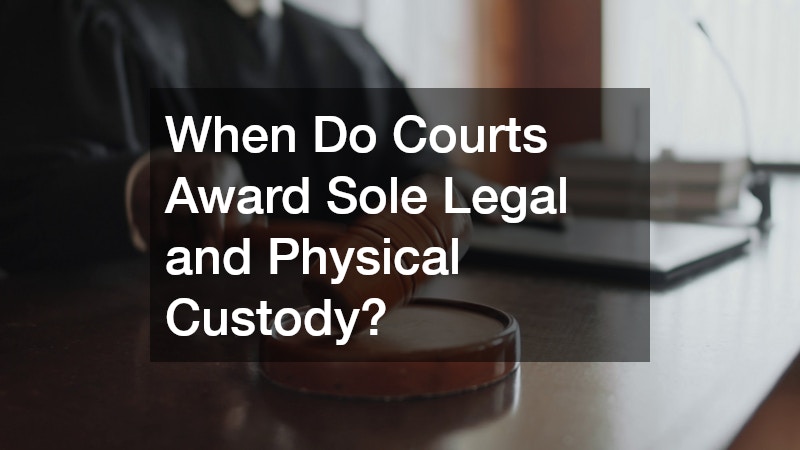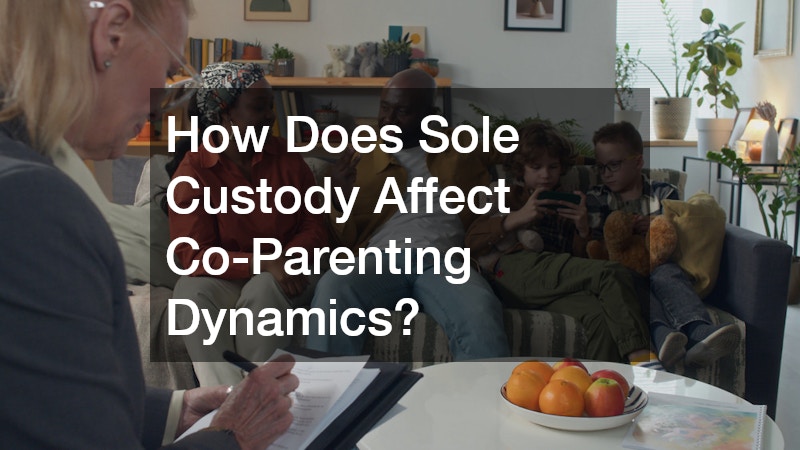Divorce is rarely easy, especially when children are involved. One of the most emotionally charged and legally complex aspects is deciding who gets custody. For many parents, understanding the different types of custody arrangements can feel like learning a new language. Among the most misunderstood terms is “sole legal and physical custody.” What does it really mean? When is it awarded? How does it impact both parents and children?
Sole custody refers to a custody arrangement in which one parent has the exclusive legal and physical responsibility for the child. This setup is different from joint custody, where both parents share duties and decisions. Courts may grant sole custody when they believe it’s in the best interest of the child, typically in cases involving abuse, neglect, or long-distance living arrangements.
Let’s break down exactly what sole custody involves and what it means for your family’s future.
Sole Legal vs. Sole Physical Custody: What’s the Difference?
When discussing custody, it’s important to understand that “legal” and “physical” custody are two separate components, and a parent can be granted one without the other.
Sole Legal Custody
- Grants one parent the exclusive right to make major decisions about the child’s life.
- Covers areas such as education, healthcare, religion, and general welfare.
- The non-custodial parent may still be informed but cannot make binding decisions.
Sole Physical Custody
- The child lives full-time with one parent.
- The other parent may have visitation rights, but the custodial parent manages daily care and routines.
- This is often granted when one parent lives far away or is deemed unfit to provide daily care.
Combined: Sole Legal and Physical Custody
When both are awarded to one parent, that parent is solely responsible for the child’s well-being, both in terms of decision-making and day-to-day care.
When Do Courts Award Sole Legal and Physical Custody?

In most states, courts prefer joint custody, believing that children benefit from having both parents actively involved. However, sole legal and physical custody may be granted under specific circumstances where joint custody isn’t feasible or safe.
Common Scenarios Where Sole Custody Is Granted:
- Abuse or neglect: If one parent has a documented history of physical, emotional, or substance abuse.
- Incarceration: A parent is in prison or has committed serious offenses.
- Abandonment: One parent has shown no interest in the child’s life.
- Severe conflict or instability: When parents are unable to cooperate, they create a toxic environment for the child.
- Distance: One parent moves to another state or country, making joint custody impractical.
Courts make these decisions based on the child’s best interest. They’ll review each parent’s history, current living situation, and ability to provide a stable home.
What Rights Does the Non-Custodial Parent Have?
Even if a parent loses sole legal and physical custody, it doesn’t always mean they’re cut off from the child’s life.
Potential Rights of the Non-Custodial Parent:
- Visitation: Courts may award supervised or unsupervised visitation depending on the situation.
- Access to records: In some cases, the parent may still access school and medical records.
- Appeals and modifications: A non-custodial parent can petition the court for modification of custody terms if circumstances change.
However, the custodial parent has the final say on key issues, and courts will enforce boundaries if past behavior suggests the child could be harmed by too much access.
Sole Legal and Physical Custody: Pros and Cons
While sole custody can bring clarity and stability, it also comes with challenges. Here’s a balanced look at what it may mean for both parents and children.
Pros:
- Consistency for the child: One home, one set of rules.
- Efficient decision-making: No need to negotiate every major decision.
- Safety and well-being: Ensures children are protected from a harmful or unstable parent.
Cons:
- Strained parent-child relationship: The non-custodial parent may drift away over time.
- Increased pressure on custodial parent: Sole responsibility can lead to burnout.
- Legal challenges: The non-custodial parent may seek modification, resulting in ongoing legal battles.
It’s important to weigh these factors carefully and consider how they apply to your unique situation.
How Can a Parent Get Sole Custody?
Seeking sole legal and physical custody is a serious legal undertaking. Courts require substantial proof that the other parent is unfit, or that sole custody is in the child’s best interest.
Steps to Take:
- Hire a family law attorney: You’ll need expert legal support to build a strong case.
- Document everything: Record instances of abuse, neglect, or irresponsible behavior.
- Provide evidence: Medical records, police reports, text messages, and witness statements can be powerful.
- Demonstrate stability: Show that you can offer a consistent, loving, and safe home.
- File a petition: Submit your request for sole custody to the family court.
- Attend hearings: Be prepared to present your case and respond to challenges.
Even if you don’t win sole custody right away, you may be awarded temporary custody during the proceedings to protect your child.
What If the Other Parent Disagrees?
Custody battles are emotional and often contentious. If one parent seeks sole custody while the other wants joint custody or visitation, a legal conflict is likely to arise.
What to Expect:
- Mediation may be ordered before court hearings to resolve disputes.
- A Guardian ad Litem (GAL) might be appointed to assess what’s best for the child.
- Both parties present evidence, and the judge makes the final decision.
- Appeals are possible, but only with new evidence or legal grounds.
It’s essential to stay calm, document interactions, and avoid negative communication, as all behavior can be used in court.
How Sole Custody Affects Child Support
Many parents assume that custody automatically impacts child support, but that’s not always the case.
Key Points:
- The non-custodial parent is typically required to pay child support, even with limited visitation.
- Support amounts are based on income, number of children, and state guidelines.
- Failure to pay support can lead to legal consequences, including wage garnishment or jail time.
Even if you have sole custody, you cannot deny visitation due to unpaid support, and vice versa. They are separate legal issues.
Can Custody Arrangements Be Changed Later?
Yes. Custody is not always permanent. Life circumstances change, and courts recognize that.
You may request a modification if:
- The non-custodial parent becomes stable or moves closer.
- The custodial parent is no longer able to care for the child.
- The child’s needs evolve with age or development.
- There’s evidence of endangerment or neglect in the current home.
To initiate a change, you’ll need to file a motion for modification and provide new evidence. The court will again evaluate what’s best for the child at that point in time.
How Does Sole Custody Impact the Child Emotionally?
While sole custody may provide safety and structure, it can also lead to emotional challenges for the child.
Common Emotional Effects:
- Feelings of loss or abandonment toward the absent parent.
- Divided loyalties if the non-custodial parent is still involved.
- Increased attachment to the custodial parent, which may be intense or anxious.
Parents should:
- Encourage healthy communication with the non-custodial parent (if appropriate).
- Seek therapy or counseling for the child if needed.
- Maintain consistency and open dialogue to help children feel secure.
Every child reacts differently, so being emotionally available and responsive is key.
How Does Sole Custody Affect Co-Parenting Dynamics?

Co-parenting is already challenging under the best circumstances, but when one parent has sole legal and physical custody, the dynamic changes significantly. In sole custody cases, the custodial parent makes all major decisions without needing the input of the other parent. This can create friction, especially if the non-custodial parent feels left out or marginalized.
Communication may become limited to logistical matters like visitation schedules or emergencies. It’s important for both parents to understand their roles and respect the boundaries established by the court. For effective co-parenting, the custodial parent should aim to keep interactions neutral and child-focused, while the non-custodial parent should avoid confrontational or guilt-inducing behavior.
If possible, co-parenting counseling or parallel parenting strategies may help reduce conflict and maintain a level of cooperation that benefits the child. Even when one parent has full authority, maintaining a respectful and predictable relationship can positively affect the child’s emotional stability.
Is Sole Custody Always Permanent? Understanding Long-Term Implications
While sole legal and physical custody can offer immediate stability, it’s important to remember that custody arrangements are not set in stone. As children grow and circumstances evolve, either parent can request a modification to the custody order. For example, a non-custodial parent who previously struggled with substance abuse may undergo successful rehabilitation and wish to become more involved in the child’s life.
Additionally, as children mature, courts may consider their preferences, especially in their teenage years. A 14-year-old child, for instance, might express a desire to spend more time with the other parent, prompting the court to reconsider custody terms.
For the custodial parent, it’s wise to maintain clear records of the child’s upbringing, educational performance, and any issues that arise, as this can be valuable if changes are proposed later. While sole custody provides structure in the short term, it’s essential to be prepared for the possibility of future legal reviews—and to always focus on the child’s best interest over parental conflict.
Conclusion: Making the Right Custody Choice for Your Family
Understanding sole legal and physical custody is crucial for parents navigating the difficult path of divorce. It’s not a one-size-fits-all solution, and the decision should center around the child’s safety, development, and emotional well-being. While it grants one parent full authority and responsibility, it also comes with legal and emotional challenges that must be carefully managed.
If you’re considering seeking sole custody, consult with a qualified family law attorney and thoroughly assess your family’s needs. With the right approach, you can make a decision that prioritizes your child’s best interest, both now and in the future.
